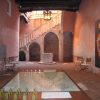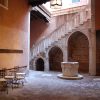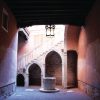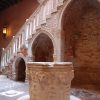Carlo Goldoni’s plays were a sharp and accurate reflection of the world of eighteenth-century Venice. His numerous works – many of which are still performed throughout the world – made the city into a sort of observatory in which to investigate all the various aspects of the changing world of his age: cultural development and social conflict; the gradual emancipation of women; the emergence of characters who had never before been represented on the stage.
The main salon of the museum gives the opportunity to the visitors to enter in the atmosphere of that world. On the walls are various enlargements of the engraved illustrations which figure in the last complete edition of Goldoni’s works published in the 18th century (by Zatta in Venice, 1788-1795). These images are a free interpretation of the main themes around which Goldoni’s plays are constructed: masked figures and individual characters; the world of women; comic theatre; travellers and adventurers; the family on stage; noblemen, merchants and plebeians. Each of these various “sections” is illustrated in such a way as to bring out the main critical ideas within the plays Goldoni produced in a Venice that was still at the forefront of European theatre.
In the “portico” on the ground floor, close to the water-gate, a reproduction of the topographical plan by Lodovico Ughi (1729) has been superimposed upon an educational game-board. It is the most detailed ordnance-survey document representing the urban conditions of 18th century Venice. It depicts in highlight the areas in which the various town dwellings where Goldoni lived were located, as well as those where the many buildings which still made Venice one of the capitals of theatre culture in the 18th century stood.
In the course of the 18th century, Venice went through an animated season of novelties and of settling down for its theatrical facilities. Although a few play-theatres were shut down due to their being obsolete or inadequate, others were inaugurated; the most important theatres were subject to renovation, updating and new decorating. In the age of Goldoni the city could still count on around fifteen theatres, which engaged authors, actors, singers, musicians, stage-designers – the protagonists of showbiz offerings – in a prolific production, both under the aspect of quantity and that of variety.
_
Downloads
Booklet to visit the Museum
Casa di Carlo Goldoni. La Casa del suo Teatro
![]() – Italiano (PDF 839 Kb) >
– Italiano (PDF 839 Kb) >
– English (PDF 858 Kb) >
– Français (PDF 840 Kb) >




